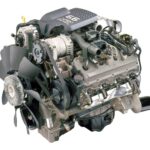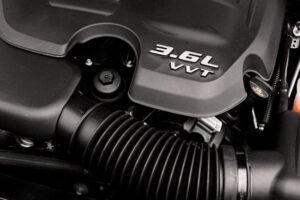The Duramax engine, introduced in 2021, resulted from a joint venture between Isuzu and General Motors. This engine replaced the 6.2 and 6.5-liter Detroit engines and is popular for its reliability. Despite such, some models are problematic. So, which Duramax years should you avoid?
Here are the years of Duramax engines to avoid:
- 2001 to 2004 LB7
- 2004 to 2005 LLY
- 2006 to 2007 LBZ
- 2007 to 2012 LMM
- 2007 to 2016 LML
These engines are prone to numerous problems, including issues with the fuel lift pump, water pump, fuel injector, piston, and fuel pressure lift pump.
Read on to learn more about the Duramax years to avoid, including some of the problems that make those engines unreliable.
Duramax Years to Avoid

If you are thinking of buying a vehicle with a Duramax engine, try to avoid any model from the following years:
1. 2001 to 2004 LB7
6.6-liter V8 Engine with Four Valves per Cylinder
Being the first generation of the Duramax engine, the LB7 was quite remarkable. It is a 6.6-liter V8 engine with four valves per cylinder. Plus, it has a cast-iron engine block with aluminum heads.
Can Deliver 300 HP at 3,100 RPM
The tech specs are also good, delivering 300 HP at 3,100 RPM. Meanwhile, it has a torque of 520 lb-ft at 1,800 RPM. This engine is found in cars like the GMC Sierra HD and Chevrolet Silverado HD.
While the inaugural Duramax engine has been successful, it also has several problems. As with any brand-new engine, it wasn’t perfect and had several issues, which allowed the manufacturer to improve the succeeding models.
Prone to Cracking Injector
The injector is one of the most common problems with 2001 to 2004 LB7 engines. GM knows this issue, and they have corrected the design. They have also provided a seven-year or 200,000-mile warranty on the newer models to give users peace of mind.
The injectors are prone to cracking, which can compromise longevity. A common sign that it is problematic is when there is constant smoke when idling.
Absence of a Factory Lift Pump
The absence of a factory lift pump is another issue with the LB7 engines from 2001 to 2004. They utilize a high-pressure common rail fuel system with direct fuel injection. Since it does not have a fuel lift pump, the CP3 injection pump is prone to strain.
Especially after adding several modifications, the system can be too difficult to handle, making the engine prone to damage.
Faulty O-rings
These engines can also have faulty O-rings, which several users reports are prone to leaking. The O-ring deteriorates through the years, which will cause a fuel leak and increase the chances that air will get into the system.
Duramax LB7 Technical Details
- Horsepower: 235 to 300 HP
- Torque: 500 to 520 lb/ft
- Transmission: Five or six-speed Auto Allison transmission
- Weight: 835 pounds
- Block Material: Cast Iron
- Cylinder Head: Cast Aluminum
- Connecting Heads: Forged steel
- Crankshaft: Forged steel
- Fuel Injection: Direct Injection High-Pressure Common Rail
with Bosch CP3 Injection Pump - Engine Oil Capacity: 10 quarts
- Fuel Tank Size: 26 gallons
- Maximum Engine Speed: 3,250 rpm
- Bore: 4.055 inches
- Stroke: 3.897 inches
- Compression Ratio: 17.5:1
2. 2004 to 2005 LLY
Company’s Second-generation Engine
In the middle of 2004, Duramax introduced the LLY engine. This is the company’s second-generation engine. It was also known as the 2004.5 engine, which you can find in GMC Sierra and Chevrolet Silverado.
Most of its components include those from the first-generation engine but with some improvements. Despite such, there were still problems.
Overheating Issue
A common issue with the LLY engine from 2004 to 2005 is overheating. It is especially common when using a vehicle for towing.
Smaller Radiator
The radiator is smaller than the succeeding engines from Duramax, which contributes to overheating. It can also be because of a faulty fan clutch or a damaged water pump.
Have Restrictive Components
The LLY engines have a bad reputation because of having restrictive components, which will limit the overall performance of your vehicle. A good example of such is the turbo air inlet manifold. It works harder than necessary, putting too much strain on the engine, and making it more prone to problems.
Head Gasket Failure
Head gasket failure is also a common occurrence in these engines. Aside from the bad cooling system, one other cause of this issue is the turbocharger’s bad design. Your choice of aftermarket components can also be contributory.
Weak Fuel Pressure Relief Valve
The fuel pressure relief valve is another issue to watch out for in this engine. It is a spring-loaded plug at the rear of the driver-side fuel rail.
It can protect the rail in case of an over-pressure. Nonetheless, it can also become weaker over time, especially when it overworks. This will prevent the engine from delivering its peak performance.
Duramax LLY Technical Details
- Horsepower: 310 HP
- Torque: 520 to 605 lb/ft
- Transmission: Five-speed Auto Allison transmission
- Weight: 835 pounds
- Block Material: Cast Iron
- Cylinder Head: Cast Aluminum
- Connecting Heads: Forged steel
- Crankshaft: Forged steel
- Fuel Injection: Direct Injection High-Pressure Common Rail
with Bosch CP3 Injection Pump - Engine Oil Capacity: 10 quarts
- Fuel Tank Size: 26 gallons (short bed), 34 gallons (long beds)
- Maximum Engine Speed: 3,250 rpm
- Bore: 4.055 inches
- Stroke: 3.897 inches
- Compression Ratio: 17.5:1
3. 2006 to 2007 LBZ

Can Generate Power of Up to 360 HP and a Torque of 650 lb-ft
Many diesel enthusiasts love the LBZ. Generating power of up to 360 HP and torque of 650 lb-ft, its overall build has significant improvements to make it better than many of its competitors. It is reliable and has no systems that regulate emissions.
While it is good overall, many are still unhappy with its serious problems, so it is included in our list of Duramax engines to avoid.
Cracked Piston
A recurring issue in the LBZ engines is a cracked piston. The latter is made of cast aluminum. It will most likely not experience problems at 600whp.
Beyond such, however, a piston failure is imminent. This should not be an issue for those who plan to keep the stock engine. It is only a significant problem for those planning to add a mod.
Water Pump Failure
Water pump failure is also a recurring problem in LBZ engines from 2006 to 2007. The pump’s main function is to push the engine coolant into the cooling system. As a result, it will minimize overheating.
Prone to Damage Plastic Impeller
However, LBZ engines come with a plastic impeller, a rotating fan that allows the coolant to rotate. The material is weak and brittle, so that it can be easily prone to breakage.
Often Suffer from the Failure of Glow Plugs
Additionally, LBZ engines also often suffer from the failure of glow plugs. During cold temperatures, diesel engines will absorb a lot of heat, making it difficult to start. The glow plug can help combat such a problem.
Control Module Issue
Nonetheless, the same part can also be the issue itself. It has something to do with the control module, which can suffer from current overload. The tip is a piece of metal that can break off and damage the engine.
Duramax LBZ Technical Details
- Horsepower: 360 HP
- Torque: 650 lb/ft
- Transmission: Six-speed Auto Allison 1000 transmission / ZF650 manual transmission
- Weight: 835 pounds
- Block Material: Cast Iron
- Cylinder Head: Cast Aluminum
- Connecting Heads: Forged steel
- Crankshaft: Forged steel
- Fuel Injection: Direct Injection High-Pressure Common Rail
with Bosch CP3 Injection Pump - Engine Oil Capacity: 10 quarts
- Fuel Tank Size: 34 gallons
- Maximum Engine Speed: 3,250 rpm
- Bore: 4.055 inches
- Stroke: 3.897 inches
- Compression Ratio: 16.8:1
Again, which Duramax years to avoid? Avoid buying GM vehicles with the following Duramax engines:
- 2001 to 2004 LB7
- 2004 to 2005 LLY
- 2006 to 2007 LBZ
- 2007 to 2012 LMM
- 2007 to 2016 LML
Select GM vehicles with newer model years as they have improved performance.
4. 2007 to 2012 LMM
Had Ratings of 365 HP and 660 lb-ft of Torque
The LMM engine introduced in 2007 replaced the LBZ engine. Based on SAE certifications, this engine had ratings of 365 HP and 660 lb-ft of torque.
Has Many Innovative Features to Deliver Incredible Power
The engine was built with an emphasis on tightening emissions standards. Despite such, it has many innovative features to deliver incredible power, such as the intake airflow valve.
Excessive Regeneration of Diesel Particulate Filter
Despite the improvements from the previous versions, the 2007 to 2012 LMM engines exhibit several problems. For instance, many were unhappy with its Diesel Particulate Filter.
The latter suffers from excessive regeneration, especially during long drives. It will put back pressure on the engine. In turn, problems with the fuel and cooling systems can be apparent.
Popular for Having Leaking Transmission Lines
Additionally, the 2007 to 2012 LMM engines are also known for having leaking transmission lines. The main function of the cooling line is to help ensure that there is enough coolant circulating in the system to prevent overheating.
Nonetheless, the cooling line has a significant flaw, making it crimp and leak.
Low Fuel Rail Pressure
A low fuel rail pressure can also be an issue in the LMM engine from 2007 to 2012. Seeing this error in your dashboard is most common when the weather is hot.
Such can also be the case when you tow heavy equipment, especially when using an old high-mileage vehicle. This problem can result in minimal power output.
Piston and Crankshaft Failure
It is also common for the users of this engine to report the failure of the piston and crankshaft. You will most likely not experience such problems if you use a stock engine without modifications.
Nonetheless, if you have added mods, note that it can push the engine’s power, putting additional strain that can damage the piston and crankshaft.
Duramax LMM Technical Details
- Horsepower: 365 HP
- Torque: 660 lb/ft
- Transmission: Six-speed Auto Allison 1000 transmission
- Weight: 835 pounds
- Block Material: Cast Iron
- Cylinder Head: Cast Aluminum
- Connecting Heads: Forged steel
- Crankshaft: Forged steel
- Fuel Injection: Direct Injection High-Pressure Common Rail
with Bosch CP3 Injection Pump - Engine Oil Capacity: 10 quarts
- Fuel Tank Size: 26 gallons (short bed), 34 gallons (long bed)
- Maximum Engine Speed: 3,250 rpm
- Bore: 4.055 inches
- Stroke: 3.897 inches
- Compression Ratio: 16.8:1
5. 2007 to 2016 LML

Designed for Full-sized Heavy-duty Trucks
An engine designed for full-sized heavy-duty trucks, the Duramax LML is efficient and powerful. From aluminum heads to rail fuel injection, it has many features that the maker has developed to ensure an incredible performance.
However, despite its many benefits, it is one option that is often named when talking about the worst Duramax engine.
Have a Reputation for the Sudden Failure of the Fuel Pump
The 2007 to 2011 Duramax LML engines have a reputation for the sudden failure of their fuel pump. Metal shavings can spread in the engine, resulting in contamination.
If you experience this problem, you will need a fuel system kit. You will need to clean the tank to eliminate the debris and ensure clean fuel for optimal performance.
Injector and Injection Pump Issues
The engine is also known for its injectors and injection pump problems. The engine has a state-of-the-art injector design, allowing significantly higher power production than its predecessors.
Poor Lubrication and Contamination
However, it can also have several problems, including poor lubrication and contamination.
Inexpensive and Can Deliver Many Benefits
The constant need to fill the engine with diesel exhaust fluid can also be a problem for some. Nonetheless, it is inexpensive and can deliver many benefits, so its use in LML engines is justifiable.
Duramax LML Technical Details
- Horsepower: 397 HP
- Torque: 765 lb/ft
- Transmission: Six-speed Auto Allison transmission
- Weight: 835 pounds
- Block Material: Cast Iron
- Cylinder Head: Aluminum
- Connecting Heads: Forged steel
- Crankshaft: Forged steel
- Engine Oil Capacity: 10 quarts
- Fuel Tank Size: 36 gallons
- Maximum Engine Speed: 3,450 rpm
- Bore: 4.055 inches
- Stroke: 3.897 inches
- Compression Ratio: 16.0:1
Tips and Tricks to Avoid Duramax Engine Problems
If you already have a vehicle with one of the worst Duramax engines, you must be more proactive in care and maintenance. By doing so, you can avoid the most common problems and extend the engine’s lifespan. Below are some of the best things to do:
1. Clean the Air Filter
Compared to gas engines, diesel engines like Duramax are known for using more fuel. As a result, the filters will get dirty quicker. The more dirt it accumulates, the less efficient it becomes.
It also increases the possibility of fuel contamination. Pay attention to the color to know when it is time to clean. At some point, cleaning may no longer suffice. Instead, you will need a filter replacement.
2. Replace the Fuel Filters
It is not only the air filters you should be taking care of. Equally important is the fuel filter. Since diesel is less refined than gas, it can be more prone to contamination.
When not given proper attention, it will decrease horsepower and cause the engine to stall. The best practice is to replace the fuel filter after running 10,000 to 15,000 miles.
3. Take Care of the Radiator
You can avoid many of the most common Duramax engine problems if you ensure the optimal functionality of the radiator. The main responsibility of the latter is to transfer heat effectively.
Hence, with effective thermal management, overheating is less likely. Diesel engines will run hotter than their gas counterparts. A regular radiator fluid exchange is necessary to keep the cooling system running efficiently.
4. Schedule an Oil Change
This is helpful not just in Duramax engines but also in other types of engines. A regular oil change should be done within 5,000 to 6,000 miles. Schedule an oil change earlier if you often drive in harsh conditions that can put more strain on the engine.
It ensures proper lubrication so all engine parts will work as they should. Aside from helping fuel efficiency, it can also prolong an engine’s life expectancy.
Frequently Asked Questions
What Are the Best Duramax Engines?
Some of the best Duramax engines that can provide reliable performance through the years are the following:
- 2010 to 2017 Duramax LGH
- 2011 to 2016 Duramax LML
- 2011 to 2021 Duramax XLD25
- 2012 to 2021 Duramax XLD28
- 2014 to 201 Duramax LWN
- 2017 to 2021 Duramax L5P
- 2019 to 2021 Duramax LM2
What Are the Worst Duramax Engines?
While Duramax is a high-performing and reliable engine, some years can be problematic, including the following:
- 2001 to 2004 LB7
- 2004 to 2005 LLY
- 2006 to 2007 LBZ
- 2007 to 2012 LMM
- 2007 to 2016 LML
What Are the Most Common Problems of Duramax Engines?
While it has impressive overall construction, many of the parts of the Duramax engines can be prone to failure, including the fuel injector, water pump, glow plug, fuel pressure relief valve, and O-rings. It can also overheat, common in older engines and when running in harsh environments.
What Is the Life Expectancy of Duramax Engines?
On average, a Duramax engine will last 200,000 to 300,000 miles. You need to exert effort in its care and maintenance to optimize performance as the mileage increases. The driving conditions and specific year/model of the engine will hugely impact how long it will last.
In Closing – Duramax Years to Avoid
Knowing the Duramax year to avoid can be a lifesaver! You can choose an engine that will deliver optimal performance and minimal problems. You can spare yourself from the headache of frequent and costly repairs. As noted above, below are the most problematic years of Duramax engines:
- 2001 to 2004 LB7
- 2004 to 2005 LLY
- 2006 to 2007 LBZ
- 2007 to 2012 LMM
- 2007 to 2016 LML
Most of the Duramax years you should avoid are from the engine’s older generations. Such is expected because the technologies at that time were much limited compared to the innovations in today’s engines.
Many parts can be prone to problems, from the fuel injector to the water pump, compromising the engine’s overall performance.
Read next:
7 Most Common 5.7 Hemi Problems
Is Your Engine an Interference Engine?
What Is the Difference Between a 2-Stroke and 4-Stroke Engine?









